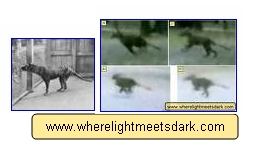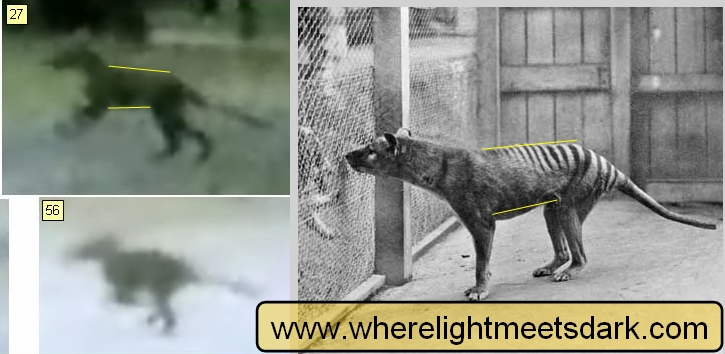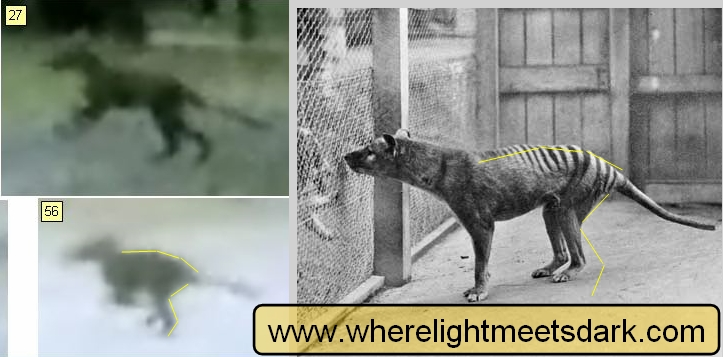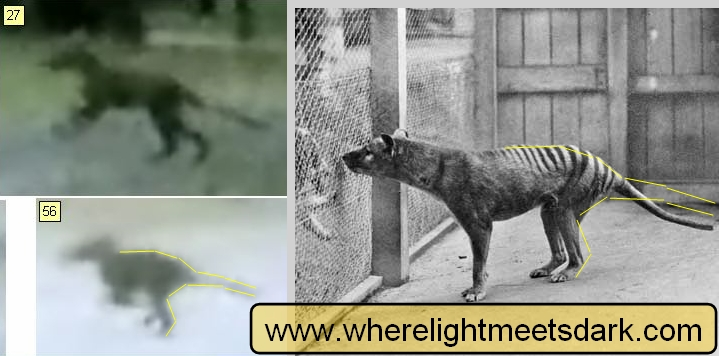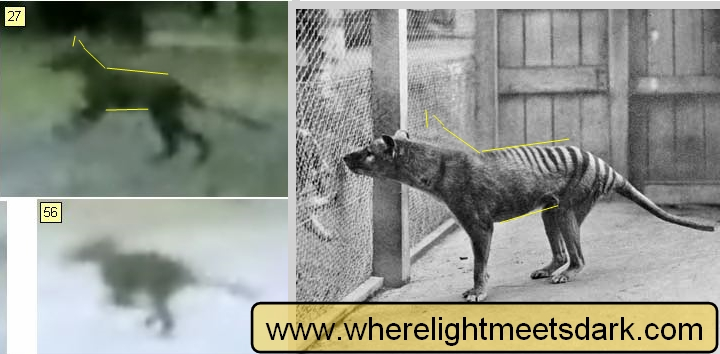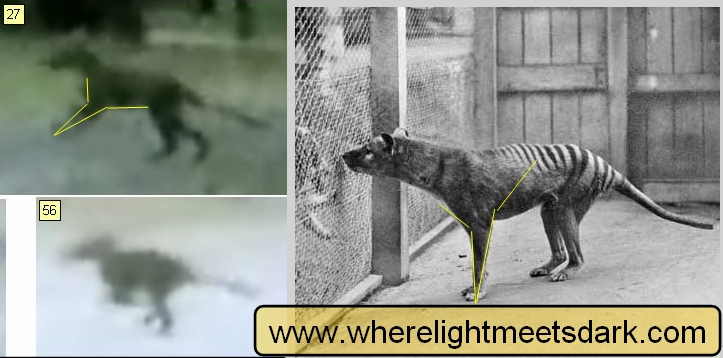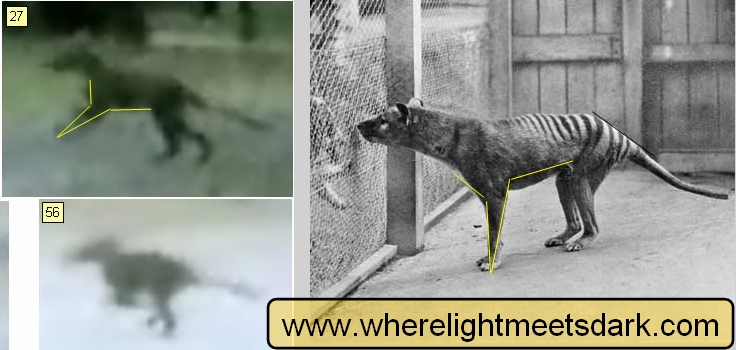Doyle thylacine - comparison with a known thylacine
Overview
This article is the third in a series analysing the Doyle thylacine footage.
Introduction
With my recent article on the WA thylacine footprint, the recent yowie footprints news and at least two other footprint analyses I am conducting offline, I was on the hunt for images of thylacine footprints. In the middle of browsing countless thumbnail images I arrived at a search results page which showed two interesting thumbnails at the same time. The first was a composite image from my second analysis of the Doyle footage. The second was a still-frame from David Fleay's footage of a real, live thylacine, captured in the 1930s.
I was immediately struck by the similarity.
Recap
To recap the story. There is footage circulating on the internet, credited to Liz and Gary Doyle and believed filmed in 1973 in South Australia. The poor resolution of the MPEG copies available for analysis instantly makes the Doyle footage inadmissible as evidence for the mainland survival of the thylacine. Obviously, this does not automatically mean it is not genuine and despite the limitations in resolution, much can still be usefully discussed.
The footage itself runs for only a few seconds and shows a quadrupedal animal running from right to left across the screen. It appears to have been filmed through the windscreen of a moving vehicle. The animal's running style is probably best described as clumsy in appearance and one author that claims to have seen two post-extinction thylacines in Tasmania (using the pseudonym "Tigerman") suggests it matches that of the animals he saw.
In my first analysis of the Doyle footage I captured a significant number of frames from the MPEG version of the footage and compared them with known footage of thylacines. My conclusion was that "whilst I ... cannot conclusively state that the animal can only be a thylacine, I feel that all observable features of the 1973 animal remain consistent with the morphology of a thylacine." These "features" included "the overall body proportions ... including the dimensions of the trunk of the body, the head shape, ear shape, ear position, tail thickness, base of the rump, tail posture, forepaw position, forepaw proportion and curviture of the spine."
In my second analysis I had a higher resolution copy of the footage available, but still in MPEG format. That analysis was primarily concerned with the apparent appearance of stripes on the animal. The conclusion was that these apparent stripes were most likely caused by the nature of the MPEG encoding of the file. I acknowledged at the same time that an absence of stripes, especially in such a poor quality copy of the film, would not exclude the animal being a thylacine. As a final thought I shared the four screen captures which best illustrate the animal's unusually stiff tail - and these are the images I will now discuss further below.
The images for comparison
These are the four Doyle footage screen captures (frames 25, 27, 43 and 56 from my second analysis) and the screen capture from David Fleay's footage - at the thumbnail size at which they were returned to me by a popular search engine whilst searching for images of thylacine footprints.
As just mentioned, I was immediately struck by the similarity. I found the proportions of the top-right Doyle frame (and in particular the hind legs, torso and tail) so similar that I felt compelled to immediately carry out another analysis.
The present comparisons were undertaken without reviewing either of my previous analyses. This was done intentionally in order to avoid "leading" this comparison in a specific direction (as much as possible).
Body proportions
This first comparison was designed to test whether the body proportions between the Doyle and Fleay images matched. Two yellow lines were drawn over Doyle frame 27 using a tool which produces straight lines. In contrast, previous analyses used tools which "smoothed out" curves between points that I would indicate to the software. In this comparison I specifically wanted to work with disjoint straight lines. I was concerned with relative proportions more than the exact outline or shape (although these are obviously related).
The yellow lines were then cloned, proportionally enlarged, and slightly rotated in order to best approximate the same positions on the Fleay image. Specifically, the dorsal (top) line was drawn (on the Doyle image) from the angle between the base of the neck and the anterior (front) of the back, to the angle where the back clearly tapers away towards the tail. The ventral (bottom) line was drawn (on the Doyle image) from the posterior-most (rear-most) edge of the foreleg, where its outline joins the chest's outline, to the anterior-most (forward-most) edge of the hindleg, also where its outline joins the outline of the chest.
The scaled, rotated dorsal line was then aligned as closely as possible on the Fleay image and the ventral (bottom) line proved almost perfectly aligned - indicating the angle and length of the spine relative to the chest, is identical between images.
It should be noted that the two animals may not be identically perpendicular to the angle of the cameras filming them. In the Fleay image the forelegs are clearly seen to be nearer the camera than the hindlegs. By inspection, it would seem as if the Doyle animal is running at a similar angle to the thylacine in Fleay's image but there can be no reliable way to demonstrate this.
Body proportions from the second thumbnail
The feature which struck me about the lower thumbnail was the way in which the base of the tail tapers towards the tail itself. This time three clear segments are seen on the dorsal surface of the Doyle animal. These were traced accordingly.
On the underside the direct line between the leg and the tail was traced. In order to provide additional vectors for comparison, the rest of the leg was also traced.
Specifically, the tail was not traced as the purpose here was to compare the triangular base of the tail.
Again, the lines were proportionally scaled and rotated. This time the uppermost leg segment was aligned as best as possible. It can be seen that each segment of the leg is in close proportion between images, although the leg is at a slightly different angle relative to the body. Further, three separate segments are clearly seen on the Fleay image also, although again at a different angle. The proportions of these three segments again match between photos.
Adding the tail
The next step was obvious - add the tail.
The tail appeared to have one bend near the centre of its length; thus, it was traced (again on the Doyle image) using two segments for the dorsal surface and two segments for the ventral surface. All lines were again proportionally scaled as before but this time it was matched to the Fleay thylacine by the length of the tail. Based on this match, the other metrics (that being the spine and hind leg) are now clearly relatively smaller. This would indicate the Doyle animal has a relatively longer tail than the Fleay thylacine, although arguably only marginaly.
The short neck
During these comparisons one feature became obvious - the neck of the Doyle animal appears relatively shorter than that of Fleay's thylacine.
For this comparison the original two body lines were re-used and the neck and one ear were added to the tracing using three segments. These were scaled and rotated as required and matched again based on the dorsal and ventral surfaces of the body.
The neck is clearly seen to be shorter than that observed in Fleay's image. This may be due to a number of reasonable explanations. First, the Fleay thylacine is extending its neck in order to sniff at the man which is immediately outside its enclosure and fractionally within the frame here - this may hide the join between the top of the neck and the base of the skull, making the neck appear longer than it is; second, Doyle's animal may in fact not be a thylacine; third, the four Doyle images shown here were all captured while the animal was only on its hind feet - it may be that at this point in the running process the animal's head it relatively retracted.
The ear size is reasonably matched.
The foreleg length
Finally, we return to the foreleg. Due to the indistinct outline in the Doyle image, the tracing was modelled on a triangular shape with the apex of the triangle being at the extremity of the limb. The other two vertices were positioned where there is an obvious transition onto the chest both anterior and posterior to the leg. The front and undersides of the chest were also added.
The tracing was again proportionally scaled and rotated. This time it was matched on the apex of the triangle and the anterior edge of the foreleg. It can be seen that the posterior edge of the leg terminates at approximately the same postion on the body of the Fleay animal. Likewise, the length of the chest (forward of the foreleg) is a very close match.
The ventral surface of the torso is at a significantly different angle which I attribute to the Doyle animal's foreleg being outstretched in a forward position. The comparison is easily adjusted by rotating only that one segment of the tracing.
Adjusting for the outstretched foreleg
In this image the ventral surface of the torso has been rotated in order to match the angle shown in Fleay's animal. That segment terminates at approximately the same position on the Fleay thylacine - that being at the leading edge of the hind leg.
Note that due to limitations in the image editing software I was unable to rotate a single segment. Thus, an additional segment was drawn, in black, horizontally above the thylacine. This was then grouped with the torso segment in question and both were rotated together.
By coincidence, following the rotation the black segment has been transcribed along a portion of the Fleay thylacine's spine near its tail. This is inconsequential and irrelevant to the analysis.
Summary
In summary, it was shown here that a number of morphological features are proportionally consistent between a known thylacine (Fleay's) and the animal in Doyle's footage. These are the three segments visible on the spines of both animals, all segments of the hind leg, the length of the foreleg, the distance between the leading edge of the hind leg, at the ventral surface of the torso, to the trailing edge of the foreleg, again at the ventral surface of the torso, the chest (forward of the foreleg) and with less precision (due to the shorter measurement), one ear.
The Doyle animal's tail is proportionally marginally longer than the known thylacine and its neck is proportionally shorter than the known thylacine.
Potential explanations were given which may explain the discrepancy between the relative lengths of the neck between the two animals.
The conclusions drawn from the two Doyle frames analysed here have not been cross-referenced against other frames available from that footage.
Conclusion
Therefore, the most that can be concluded from this present analysis is that in these two frames it appears very likely that the Doyle animal is proportionally consistent with at least one example of a known thylacine.
Taken with the conclusions drawn from the previous two analyses (as described above) I personally feel there is ongoing merit in investigating the Doyle footage further.
Specifically, it would be of benefit to make comparable measurements on and comparisons with known images of other species which resemble the Doyle animal. These might include the domestic dog (in its dozens of breeds), dingo and red fox and should take into account the ways in which mange (a skin disease which leads to the loss of large volumes of body hair) affect the appearance of these animals.
Such an analysis might, for example, reveal that a breed of dog has almost identical proportions to a thylacine, except for having a shorter neck. As such, it would make that breed a closer match for the Doyle animal than Fleay's thylacine.
Likewise, similar comparisons should be made using other known thylacine images.
Unfortunately, the workload involved in preparing such a large number of comparative analyses will probably preclude them from being prepared.
One other comparison which merits investigating is that between the Doyle footage and other body proportion measurements made by Heinz Moeller. In his book Der Beutelwolf, Moeller documents the relative dimensions for a number of comparable species, some - but not all - of which would be considered exotic in Australia.
As always, I welcome constructive criticism of the processes described here or earlier and encourage the current owners of this footage to submit it to a professional or myself (not a trained professional) for further evaluation.
The Doyle footage should also be considered against a background of numerous sightings made in south-east South Australia in the late 1960s and early 1970s. These have been attributed in one article to the release of land for farming in that area at that time and the subsequent land clearing that occurred.
Revisions
This article was first published at www.wherelightmeetsdark.com between 2006 - 2008.
This article was migrated to www.wherelightmeetsdark.com.au in July 2017.
